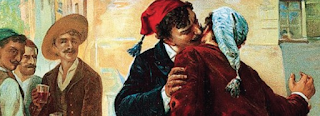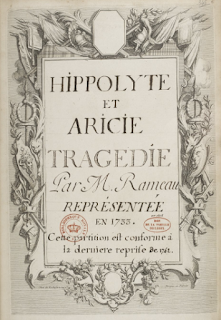Mascagni – Cavalleria Rusticana; Leoncavallo – Pagliacci
La Monnaie, Brussels, Sunday March 18 2018
Conductor: Evelino Pidó. Production: Damiano Michieletto. Sets: Paolo Fantin. Costumes: Carla Teti. Lighting: Alessandro Carletti.
CAVALLERIA RUSTICANA
Santuzza: Eva-Maria Westbroek. Lola: Josè Maria Lo Monaco. Turiddu: Teodor Ilincai. Alfio: Dimitri Platanias. Lucia: Elena Zilio
PAGLIACCI
Nedda: Simona Mihai. Canio: Carlo Ventre. Tonio: Scott Hendricks. Peppe: Tansel Akzeybek. Silvio: Gabriele Nani. Orchestra and Chorus of La Monnaie.
"Mon avis n'engage que moi," as the French say: my opinion is but my own. Come to think of it, it could be the motto of this blog. It's my view that, as well as a good production, these second-class works need vocal and orchestral glamour, southern swagger, whatever the Italian for Schmaltz is, to work. Damiano Michieletto's production is what the French call "efficace": it gets the job done and, as a bonus, comes with a sprinkling of ideas. People like it. But the music-making, unusually for La Monnaie, was too much of a mixed bag to help.
Michieletto's naturalistic staging places the works in the same village, probably in the 80s (Alfio's jalopy dates from the 70s but there's a satellite dish clamped to a parapet, so we assume he bought it second-hand) and uses revolving sets. Cavalleria is played as a flashback, opening and closing with the same scene of the elderly Lucia staggering through the village crowd to fall on her son's bloody body. It takes place on a village square with a lamp-post and some patches of grass, in front of a bakery rather than a wine shop and, as the platform turns, inside it. Extras and even the fretful old Lucia in her dark pinafore are involved in realistic weighing, mixing, kneading, shaping and baking of loaves using modern machinery and a modern oven. Pagliacci offers us a village hall or school, with its gym (there are wall bars), stage and office, or green room.
Like some other directors, Michieletto finds ways to bind the two operas together. During the first, Nedda and Canio paste Pagliacci posters up on a side wall. A young baker in a yellow tee-shirt (to make sure we recognise him next time we see him, though he could or should probably have changed it in the meantime) falls in love with Nedda: Silvio. A plaster Virgin Mary with a halo of lights appears first on a shelf in the bakery, later in the gym. Santuzza shows up, pregnant, during Pagliacci to confess to a priest under it, and fall into Lucia's arms.
Among other neat ideas, during "Inneggiamo, il Signor non è morto" the stiff statue of the Virgin being paraded through the streets like a juggernaut on the men's shoulders, in a sudden stark spotlight, comes to life to point an accusing finger at Santuzza - in the latter's imagination at least. During the "Ding-dong" chorus, the children stage a hammy Passion play. And, as Tonio has got Canio drunk to stoke up his rage, the first part of the "theatre-in-the-theatre" scene is not on the second stage, but his drunken delirium behind the scenes.
It's a sound production, clever enough to sustain our interest, and it's no surprise if it travels. But as I said above, the singing and playing were a mixed bag. It was one of those performances where for one reason or another you wondered why people were cast in the roles they had. The choice of Eva-Maria Westbroek to sing Santuzza turned out to be as weird in the house as it looked unlikely on paper. She neither looked - great, gangling Dutch women that she is, here got up in the drabbest, most unflattering, frumpish costume possible - nor sounded the part. Carlo Ventre did a fine "Recitar" with some super sounds, but seemed, no doubt understandably, to have saved himself for his big moment and shot his bolt somewhat with it.
But instead of dwelling on grisly detail, let me just say that the three most-satisfactorily-cast of all, to my crabby ear were Scott Hendricks, whom I've always liked, rough round the edges though he may now be, Josè Maria Lo Monaco and Tansel Akzeybek, very convincing as Arlecchino.
The orchestra was not on great form, though the chorus was, and Evelino Pidó was too plain vanilla for my tastes in this repertoire. I could have done with more drive, blood and guts. If the truth be told, I enjoyed Pagliacci more in the tiny opera house on Syros two years ago.
Here, Maestro Wenarto does his best to make something of the ghastly aria "Stridono lassù". If I never heard it again I most certainly wouldn't miss it.
Conductor: Evelino Pidó. Production: Damiano Michieletto. Sets: Paolo Fantin. Costumes: Carla Teti. Lighting: Alessandro Carletti.
CAVALLERIA RUSTICANA
Santuzza: Eva-Maria Westbroek. Lola: Josè Maria Lo Monaco. Turiddu: Teodor Ilincai. Alfio: Dimitri Platanias. Lucia: Elena Zilio
PAGLIACCI
Nedda: Simona Mihai. Canio: Carlo Ventre. Tonio: Scott Hendricks. Peppe: Tansel Akzeybek. Silvio: Gabriele Nani. Orchestra and Chorus of La Monnaie.
"Mon avis n'engage que moi," as the French say: my opinion is but my own. Come to think of it, it could be the motto of this blog. It's my view that, as well as a good production, these second-class works need vocal and orchestral glamour, southern swagger, whatever the Italian for Schmaltz is, to work. Damiano Michieletto's production is what the French call "efficace": it gets the job done and, as a bonus, comes with a sprinkling of ideas. People like it. But the music-making, unusually for La Monnaie, was too much of a mixed bag to help.
Michieletto's naturalistic staging places the works in the same village, probably in the 80s (Alfio's jalopy dates from the 70s but there's a satellite dish clamped to a parapet, so we assume he bought it second-hand) and uses revolving sets. Cavalleria is played as a flashback, opening and closing with the same scene of the elderly Lucia staggering through the village crowd to fall on her son's bloody body. It takes place on a village square with a lamp-post and some patches of grass, in front of a bakery rather than a wine shop and, as the platform turns, inside it. Extras and even the fretful old Lucia in her dark pinafore are involved in realistic weighing, mixing, kneading, shaping and baking of loaves using modern machinery and a modern oven. Pagliacci offers us a village hall or school, with its gym (there are wall bars), stage and office, or green room.
 |
| Mascagni |
Among other neat ideas, during "Inneggiamo, il Signor non è morto" the stiff statue of the Virgin being paraded through the streets like a juggernaut on the men's shoulders, in a sudden stark spotlight, comes to life to point an accusing finger at Santuzza - in the latter's imagination at least. During the "Ding-dong" chorus, the children stage a hammy Passion play. And, as Tonio has got Canio drunk to stoke up his rage, the first part of the "theatre-in-the-theatre" scene is not on the second stage, but his drunken delirium behind the scenes.
It's a sound production, clever enough to sustain our interest, and it's no surprise if it travels. But as I said above, the singing and playing were a mixed bag. It was one of those performances where for one reason or another you wondered why people were cast in the roles they had. The choice of Eva-Maria Westbroek to sing Santuzza turned out to be as weird in the house as it looked unlikely on paper. She neither looked - great, gangling Dutch women that she is, here got up in the drabbest, most unflattering, frumpish costume possible - nor sounded the part. Carlo Ventre did a fine "Recitar" with some super sounds, but seemed, no doubt understandably, to have saved himself for his big moment and shot his bolt somewhat with it.
 |
| Leoncavallo |
The orchestra was not on great form, though the chorus was, and Evelino Pidó was too plain vanilla for my tastes in this repertoire. I could have done with more drive, blood and guts. If the truth be told, I enjoyed Pagliacci more in the tiny opera house on Syros two years ago.
Here, Maestro Wenarto does his best to make something of the ghastly aria "Stridono lassù". If I never heard it again I most certainly wouldn't miss it.




Comments
Post a Comment